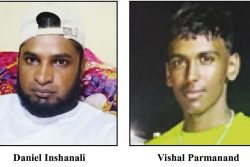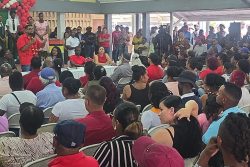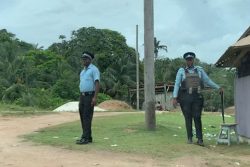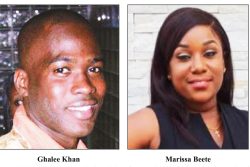As humiliating as they were – and they don’t come more humiliating than all-out 61 in an ODI and desperately hanging on for a draw in a three-day Test against Bangladesh – recent events in Chittagoing were not exactly surprising.
They simply verified the most glaring and troubling truth about West Indies cricket at present. It is the universal inability of batsman to deal with spin bowling.
While the batting on the first day of the second Test, specifically from the young brigade, Kirk Edwards, Kieron Powell and Kraigg Brathwaite, was encouraging, it did not erase worries over spin.
Statistics do not always tell the whole story. In this case, they do.
Of the 10 wickets as the West Indies struggled to 244 all out in their first innings of the first Test, nine fell to left-arm spinners Elias Sunny, on debut, and Shakib Al Hasan, both predictably aided by a dry, turning pitch. Seven of the 10 in the ODI all-out 61 went to spin.
On similarly helpful, but not impossible, surfaces in the two Tests against Pakistan in May at the Guyana National Stadium and at Warner Park in St. Kitts, the highest West Indies total was 230. The Pakistani spinners shared 32 of the 40 wickets with Saeed Ajmal’s 17 wickets at 14.47 runs each to the fore.
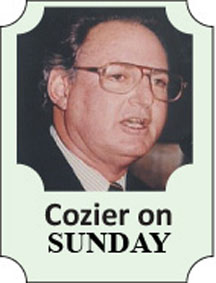 Nor is it at international level alone that the weakness exposed. Every regional season, spinners dominate the analysis.. The names are familiar – Kantasingh, Austin, Miller, Brown, Jaggernauth, Permaul.
Nor is it at international level alone that the weakness exposed. Every regional season, spinners dominate the analysis.. The names are familiar – Kantasingh, Austin, Miller, Brown, Jaggernauth, Permaul.
There were 30 totals below 200 in last season’s 31 matches. The final was over in two days with 23 of the 32 wickets to spin.
The current Regional Super50 in Guyana has been anything but. ESPN’s live television coverage of the semi-finals made for painful watching before a global viewership. It was a shocking advertisement for West Indies cricket.
Up until last night’s final, there was only one total over 250 (against nine under 200) – and Jamaica’s 255 for three against CCC was based almost solely on Chris Gayle’s 147, the only hundred of the tournament.
Yet again, spin was the web that ensnared leaden-footed batsmen. Most teams used slow, not fast, bowlers with the new ball. The pitches, as always, might have been part of the equation but not excessively so.
Sunil Narine, the new off-spin/doosra conjurer, was the leading wicket-taker with 14 and an economy rate of 3.2 entering yesterday’ final.
Steve Jacobs, never previously more than an occasional bowler for Guyana, had the scarcely believable concession of 1.92 runs an over for his seven wickets. Nikita Miller’s runs-per-over average was 2.89, Kantasingh’s 2.9.
The state of affairs prompted comments on television from worried former West Indies players. All sung basically from the same hymn book. All were realistic enough to appreciate that fixing the problem requires plenty of time and a change in the way certain things are done.
Jimmy Adams, Ian Bishop and Roger Harper all cited coaching as a major factor, along with the standard of pitches.
Adams, commentating for Sky tv, raised the issue during the two T20s against England at the Oval in September. Not for the first time, Bishop alluded to it during his stint in Chittagong. Harper was on a similar track during the Regional Super50 semis.
Their point was that a players’ cricketing education – the whole package, batting, bowling, fielding and, most important, reading of the game – must start as early as elementary school, moving on from there.
As Ian Chappell has repeatedly argued, it is there that the best coaches are required, not when it is too late to correct deficiencies developed through the uncorrected habits of the players’ formative years.
Desmond Haynes was appointed West Indies batting consultant in April. He can do little more than offer advice and make a few technical suggestions. But he can’t suddenly turn water into the finest Cockspur/25-year-old XM/Angostura 1824.
There are several examples of schools and, now, academies, throughout the region that show the benefits of knowledgable coaching and influence from an early age. Many have produced our best players of late.
The WICB has belatedly got onto the right track with its High Performance Centre. The further responsibility of teaching them young before it’s too late lies with the territorial boards.
We really can’t take much more of West Indies batsmen mermerised by the turning ball.
Six months after it first surfaced, the charade over Chris Gayle’s exclusion from the West Indies team is still no nearer closure.
The WICB board of directors’ decision, taken at their recent meeting in St.Lucia, has been made public, reaffirming that, to qualify for selection, Gayle is still required to withdraw his widely-publicised critical statements “on the board and its officers” during a radio interview in April.
Gayle has responded as he did from the start. He is not one for retracting his word.
So nothing has changed in the interim.
A fiery meeting between the WICB and the West Indies Player Association (WIPA) and one-on-one discussions between Gayle and WICB chief executive Ernest Hilaire had no effect.
As it stands, both sides have dug in their heels. If he does not comply with the WICB’s directive, Gayle is likely to remain persona non grata and out of the West Indies team.
In purely cricketing terms, he is an undeniable asset as proven opening batsman feared by bowlers for his ferocious hitting.
But there is no indication that Chris Gayle will be repentant. It is an outspoken defiance that brought him into conflict with authority more than once in the past.
Given the board’s latest directive, his response was typical.
“They need to state clearly what Chris Gayle should apologise for, rather than keep saying they don’t want an apology, they want me to retract the statement now,” he said.. “They need to come clear and say what Chris Gayle should apologise for and what should Chris Gayle retract, what are the terms, really and truly”..
“So they need to make it clear rather than stating just one particular thing and leaving the public to speculate again and just make this one big issue which I’m tired of, so they need to just cut it out now.”
This is ground that should have been covered from the beginning. A swift WICB letter to Gayle, stating its objections to the substance of his radio interview, itemizing the specific points he was required to retract and giving a deadline for his reply, would have immediately settled the issue, one way or the other.
Now more contentious, distractive arguments still lie ahead.





